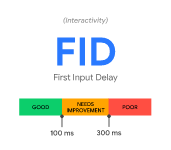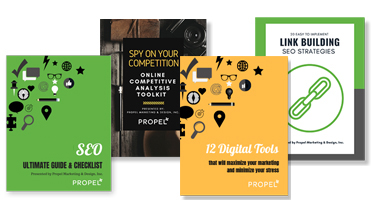When your website visitors are happy, so are you and Google. Why? Because website users make or break your online appeal. The user experience, commonly referred to as UX, is seeing some quality gains when it comes to measuring the success of your website.
Google has always prioritized sites that excel in-page experience because studies have proven that users value a great UX.
Simply put, if your user experience is unsatisfying, your website traffic and Google ranking are going to pay the price.
Today we’ll discuss:
- The new Google UX and page experience algorithm update
- The UX elements you need to pay attention to (also called user signals)
- How to achieve the best user signals through SEO (search engine optimization)
- The responsibility you have to your users’ experience
Google’s User Experience Update
Google has the ability to measure how your audience experiences your website.
This is done through reading analytics deemed important such as:
- Mobile accessibility and readability
- Page load times
- Overall page experience
- And more
Every website should be gainfully optimized to ensure that the necessary UX elements are implemented in order to achieve the best possible user experience.
When this is done correctly, sites meet or surpass the user expectations on both mobile and desktop devices, generating a positive overall world wide web existence.
In 2021 we can expect Google to update its algorithm (in fact, they’ve already stated they will), giving even more credence to overall UX, coming in the form of Core Web Vitals.
These metrics will be related to speed, responsiveness, and visual stability. And, of course, they will work with all of the existing Search UX criteria, including safe-browsing and HTTPS-security.
The current set for 2020 focuses on three aspects of the user experience—loading, interactivity, and visual stability—and includes the following metrics (and their respective thresholds):
Largest Contentful Paint (LCP): measures loading performance. To provide a good user experience, LCP should occur within 2.5 seconds of when the page first starts loading.
First Input Delay (FID): measures interactivity. To provide a good user experience, pages should have a FID of less than 100 milliseconds.
Cumulative Layout Shift (CLS): measures visual stability. To provide a good user experience, pages should maintain a CLS of less than 0.1.
And this isn’t going to be the end of UX algorithm updates from Google:
“Because we continue to work on identifying and measuring aspects of page experience, we plan to incorporate more page experience signals on a yearly basis to both further align with evolving user expectations and increase the aspects of user experience that we can measure.”
The Vital Website UX Elements
As you now know, user experience is not only important but getting more so by the second. So you need to stay on top of the new (and old) UX trends.
What are those vital elements of user experience? Review the user signals below to find out.
Page experience
Page experience offers measurable signals that detail the user’s experience on a webpage. This goes further than just the informative information provided on the page but includes the Core Web Vitals (UX regarding loading times, interactivity, and visual stability).
Dwell time
This refers to how much time a user spends on a webpage upon landing on that page from a search engine query. The time is measured from clicking on the link provided by the search engine results page (SERP) until the user leaves that page.
If your page pops up after a query and the user clicks your link (bravo) but doesn’t enjoy the experience of the page, your dwell time will suffer. Keep in mind that even if you’re fully optimized to host a great UX, the information you provide the user on the page needs to be what the user is looking for (and promised) for them to stay there, too.
Bounce rate
The bounce rate is a metric that provides insight into the amount of time visitors spend on each page of your website. If your user visits only one page, you may be dealing with a bad page experience, bad overall UX, or just plain bad content.
That said, it may also be that the user found exactly what they needed and no other website travel was necessary. If you’re getting high bounce rates, you want to look into your pages and be sure you’re doing what needs to be done for the best UX possible.
Click-through-rate (CTR)
Your CTR info measures the ratio of impressions to clicks. An impression is a metric used to distinguish the number of digital views that appear. In other words, when your ad comes up for a user or your website shows up in the SERPs, did the user click on you or pass you by? If you’re not generating a solid CTR, you’ll want to adjust your strategy.
Search intent / user intent
Exactly what it sounds like, search intent refers to the user’s overall goal when typing a query into the search bar.
It’s your job to provide pages that your users are asking for. Here’s an example: your user wants to find inexpensive yoga classes and types it into the search engine. Your site comes up and the price is right and the user is excited. Then when the user goes to sign up, it’s discovered that your brick and mortar is in another city. That’s frustrating. Optimize your pages to make the most sense for your users.
Time on page and session duration
This is the measurement of time a user spends on each page of your website and on your website as a whole. Obviously, the longer the better because that means your site is adequately fulfilling the user’s needs and expectations.
Evaluating Page Experience
All of the above-mentioned elements are page experience ranking signals that you need to be aware of and will help you make educated decisions about your users’ experiences on your webpages.
Google’s goal as a brand is to help the user find the best possible outcome to their query. Because of this, there are several algorithms that allow Google to do its job to the best of its ability.
To date, there isn’t one tool or algorithm that can measure the overall page experience but there are several individual tools and algorithms to measure a page’s experience and the combination of these metrics provide excellent UX details.
How to Optimize for Best UX Results
Anyone who knows anything about SEO knows that optimization is key. If you want to gain serious UX traction, you’ll want to check out these optimization best practices:
Content optimization
Content is a living SEO strategy, meaning it’s not a one-and-done. You need to consistently update your content with reliable, relevant information.
Doing this keeps users coming back for more and hanging out on your site for a bit, and that’s what Google likes to see.
Don’t forget about the content on the backend. Your meta descriptions need to be solid and match your site specifically so you don’t fall victim to bounce rate or dwell time problems.
Technological optimization
The techie part of optimizing consists of things like page load times, broken links, error pages, etc. But don’t think of the word “technological” here super technically.
If you offer a “help” button and the user clicks it and it takes them to a page that has nothing to do with the help they need, that’s bad, too. Be sure your links and pages make sense to the user throughout their journey with you.
Mobile optimization
This probably needs not be mentioned, but just in case. If your website isn’t properly, effectively, efficiently optimized for mobile devices your bounce rate is gonna soar. It’s real bad. You MUST be sure your website works well on all devices.
Your Responsibility to Your Users
Just like Google has a responsibility to you when you search for local, authentic, cheap Mexican food, you have a responsibility to your website users. You must provide them with the experience they’re expecting.
What’s that? Complete and utter awesomeness.
Everyone wants the same things when we think about UX: a reliable, quick, meaningful exchange between user and website.
If done correctly not only do you get the outcome you want but your user and Google do too.











![How to Write a Professional Chiropractic Bio [Template Included]](https://propelyourcompany.com/wp-content/uploads/write-a-bio-500x383.jpg)

